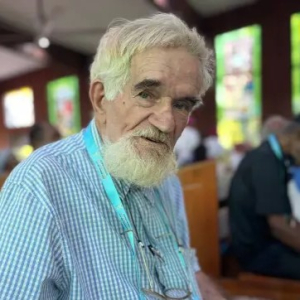Peter MALONE
A Randwick parish postscript
A Randwick parish postscript
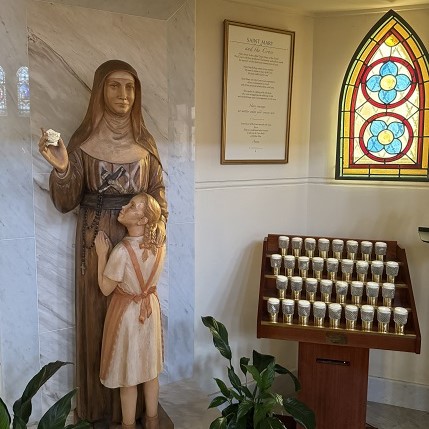
Often on the feast of St Mary MacKillop we have noted the role of Fr Matthew Smith MSC in giving her communion as she was dying. It is noted in her shrine in the Church but we did not have a photo.

Thanks for Barry Smith for going over and sending these photos.
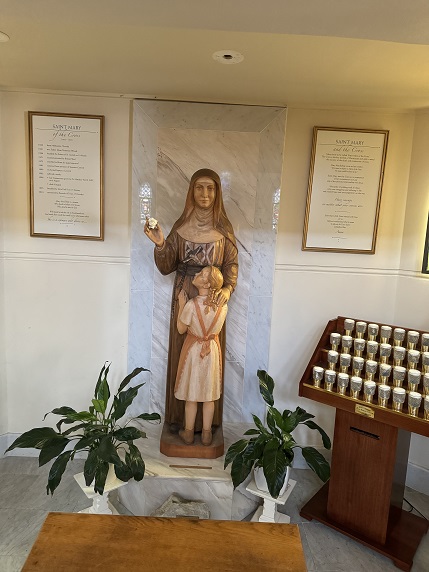
Kid Snow

KID SNOW
Australia, 2024, 127 minutes, Colour.
Billy Howle, Tom Bateman, Phoebe Tonkin, Mark Coles Smith, Hunter Page-Lochard, Nathan Philips, Jake La Torre, Robert Taylor, Tristan Gorey, Vito de Francesco, Tasma Walton.
Directed by Paul Goldman.
Once upon a time in Australia, there were travelling fairs, including a boxing troupe, with a boxing tent, featuring boxing stars ready to take on the locals as part of the show. They were popular during World War I and continued. In fact, the story opens in 1961, the main action taking place in 1971. The fairs were very popular, beginning at the time of the introduction of radio, before television, certainly long before social media. In fact, in one sequence here, a boxing bout is watched on television, black-and-white, even in 1971 before the coming of colour TV.
A reviewers noted that this is the kind of film we used to make in Australia. It is a story of ordinary people, very ordinary people, often referred to in the past as “battlers”, and not just because of the boxing, but of the struggles in making a living. The characters here all have these stories, Irish migration, fixed fights and betting, returning from Vietnam, single parents, dancing in Kings Cross nightclubs, aboriginals involved in the boxing troupes, sometimes hand-to-mouth subsistence…
In 1961, we are introduced to two boxing brothers, Rory and Kid. Their father manages them, bets, tough fights, setups, knockouts, Kid knocked down, giving way to his brother – drinking, driving, a disastrous car crash.
1971, Rory, with a limp from his leg injured in the crash, runs the touring fair, Kid being the featured boxer, the backup from some of the aborigines travelling with them. British actor, Billy Howle, plays Kid, looking unkempt, often bewildered, his brother dominating him. British actor Tom Bateman plays Rory. Mark Coles Smith and Hunter Page-Lochard feature in the entourage. Haunting them is the memory of the defeat by the national champion, Hammer (Tristan Gorey) who runs a boxing training centre.
An American journalist, played by Robert Taylor, from Life Magazine is following Hammer, interviewing Rory and Kid, trying to get a story about the boxing world in Australia, such travelling troupes not part of the American boxing scene.
A further complication is Sunny (Phoebe Tonkin), battling with her young son, Darcy, her husband has been wounded in Vietnam, time in jail, slyly picking pockets of the boxing audience, confronted by Rory, becoming a dancer with her own tent, able to survive with her son, a strange relationship with Kid who become something of a babysitter for the boy, creating a bond.
In the background the entrepreneurs are trying to organise a bout between Kid and Hammer (who hates Kid), a set up, betting and profit, Rory indebted to these entrepreneurs, forcing Kid to train.
Which means there are a number of boxing sequences, especially that final fight. However, a lot of the film focuses on personal struggles, the two brothers, resentments, yet brotherly feelings, Sunny and her situation and background, concern for Darcy, the interventions of the American journalist, a truth confrontation between the two brothers.
We know where the story is going but, satisfyingly, it is not exactly what we might have expected and the final, perhaps inevitable, visualising of the meeting leaves the audience satisfied.
- The title and the focus on Kid? In the context of his family? In the context of boxing and the troupe?
- An Australian story, the travelling boxing troupes, the fairs and the fairgrounds, the small country towns, the tents, the shows, boxing, the dancing? The audiences? The tradition from the First World War years to the 1970s?
- The West Australian settings, the small towns, the range of the countryside, deserts, farmland, the coastal sequences? Atmosphere? Musical score?
- The opening fight, the introduction to Kid, Rory, to their father? To Hammer and his trainer, Frank? The situation of the fight, the competition, the bets, the arrangements for knockouts? Kid, his fight, falling? Rory and the arrangement to win? Hammer and his dominance?
- The aftermath, the drive, Kid and his drinking, the arguments, the oncoming truck, the accident? The father’s death? Rory and his leg injury?
- 1971, Rory and the setting up of the travelling fair, the visuals of the tents, exteriors and interiors? The dance tent, the eyes, the lascivious sketches of the women?
- The entourage, Rory as the boss, unable to fight? Kid, the fighter, the locals and taking them on, the bets? The other members of the group, the aboriginal men and their presence, Bill and his being a follower? His later taking Kid’s place in being brutalised by Kid’s antagonists? The atmosphere, their characters, performances, the crowds?
- Sunny, coming into the tent, Rory watching her, picking the pockets, his confronting her, her concern about Darcy in the car? The interactions, the job, her dancing, the money, costumes, the tent and its style, the increasing audiences, their responses to her? Her suspicions of Kid, mellowing, letting him be babysitting for Darcy? The growing attraction? Darcy and his wariness, memories of father, the father and his Vietnam experience? Sunny, her explanations of herself, growing up, jail, dancing at Kings Cross, Betty teaching her? With the bigger audiences, better dresses, more elaborate performances, popularity? Rory and his approach, her resisting, Darcy attacking, her being sent away? Going to the coast, meeting Betty again, the ice cream parlour for the tourists?
- The journalist from Life Magazine, visiting Australia, comparisons with the US, his interviewing Hammer, Hammer at his gym? Interviewing Rory? Interviewing Kid? Rory’s attack on him, typing the story, present at the finale?
- Darcy taking the money, kid in pursuit, Darcy not knowing the money was Kid’s? Returning it?
- Rory, the entrepreneurs, the setting up of the fight against Hammer, Rory and his memories, Kid and his abilities, fixing the match but not telling Kid? Kid the training, the aboriginal trainers and his running, exercise? And continuing with the bouts with the locals?
- The buildup to the confrontation between Kid and Rory, the accident, Rory and his limp, the fixing of matches, treatment of Sunny? Kid leaving, driving, finding Sunny and Darcy, reuniting? The prospect of the fight?
- The decision to fight, going into training, the return, his visit to the entrepreneurs, the bet to win that he could last three rounds? The visuals of the fight, hard, collapsing, lasting the three rounds? Going to the fourth, throwing in the towel, the fans, Rory’s reaction? And the entrepreneur making money, money for Kid?
- The reconciliation with Rory, his going to find Sunny and Darcy, the ice cream parlour, and the way that the final sequence was handled, expected but controlled?
Harold and the Purple Crayon
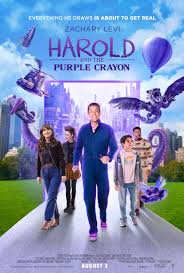
HAROLD AND THE PURPLE CRAYON
US, 2024, 90 minutes, Colour.
Zachary Levi, Lil Rel Howery, Zooey Deschanel, Benjamin Bottani, Tanya Reynolds, Jemaine Clement, Alfred Molina.
Directed by Carlos Saldanha.
Eagerness to see Harold and the Purple Crayon will depend on whether audiences grew up with Crockett Johnson’s classic story and illustrations (and his nine other books in the series as well as the television episodes). Those who do not know Johnson’s books, Harold began life in 1955 as a four-year-old, inhabiting a fantasy world where, if he needed or wanted something, he simply drew it, and there it was. However, in later books, he was an adult.
In this version, Harold is living a happy life, and drawing with his crayon, solving every need with a drawing = and there it is.. He is accompanied by his close friends, Moose and Porcupine. So, a pleasant opening, an introduction into Harold’s world, his conversations, his listening to the voice of his creator, whom he calls Old Man (voiced by Alfred Molina), but with a desire to go out into what he calls “The Real World”.
And, out he goes, in the form of Zachary Levi. Soon after Moose emerges but in human form, played by comedian Lil Rel Howery. But it takes rather a longer time for Porcupine (Tanya Reynolds) who discovers her friends missing, but does not emerge in the real world anywhere close to them, spending a long time in the search, looking for clues – and they are always purple.
And the purple crayon! Whenever Harold draws, it is with his beloved purple crayon. And, when he emerges into the real world, he simply puts his old talent into practice, drawing a purple bike, replacing a flat tire was a purple one, painting of a house, purple no limits – even later, a plane which flies through the city.
Harassed mother Teri (Zoe Deschanel) driving with her son, Mel (a likeable Benjamin Bottani), an intelligent boy who has a secret invisible mini-dragon friend, crashes into Harold and Moose on their bike. Which leads to a whole lot of adventures, searching for The Old Man, all kinds of funny and dangerous escapades and situations, and some villainy in the form of Jemaine Clement, librarian who they think will be able to find The Old Man but, frustrated with his Game of Thrones -like novel not being accepted, steals the purple crayon for dastardly purposes.
The film will appeal to boys of Mel’s age, 13 and down. As regards adult audiences, parents, the difficulty is the character of Harold, a child in an adult’s body, uttering childlike (and childish) comments (and, for this reviewer, difficult because actor Zachary Levi has played the central role in the least liked superhero films, the two Shazams).
But, within the limits it sets itself and the limits for the age audience and identifying with Harold, it can be quite a nice pastime.
- The original books, the story, the sketches? Television episodes?
- The intended audience, children, boys identifying with Harold, the age group, 13 down, identifying with Harold but also with Metal?
- The animation style, bringing Crockett Johnson’s style to life, simple, creative? And the decision to have a purple crayon? And breaking it, Mel having half and being creative, Gary stealing the half, swallowing it, having the power, bringing it up again? The adventures of the crayon?
- Harold, visually, Moose and Porcupine, visuals? Their adventures, Harold drawing, solving every problem? The voice of The Old Man, the creator? Narrative? Harold wanting to find The Old Man, to go into the Real World?
- Drawing the door, going into the real world, in the person of Zachary Levi? His voice and tone? Moose following, transformed into human, Lil Rel Lowrey, African-American? Porcupine later discovering they had gone, transformed, into the girl, but not near Harold and Moose, tracking them down? The detectives and their suspicions?
- Exhilaration in the Real World, looking for the Old Man, the man in the park, his reaction, talking to the detectives? Drawing the bicycle, enjoying the ride, the city, the transition to Teri and Mel, the absent father, the argument, Mel and his invisible dragon friend? The crash? The reaction, the flat tire – and Harold drawing the purple tire?
- Teri, exasperated, mil wanting them to come home, in the house, the room, painting the house purple, the meals and the pies? Teri and her work, not liking it, at the supermarket, her boss and his comments, getting the two to take her place, Mel and the trouble at school? The chaos in the store, pratfalls and mayhem? Teri sacked?
- Mel, the friendship, the visualising of the Dragon?
- The episode of drawing the plane, flying, the exhilaration, the dangers, and the sky writing of Teri’s phone number in the sky, asking for the old man, the incessant number of phone calls?
- The library, Gary, smug, his novel, the fewer the reading, their walking out? His infatuation with Teri? Mel and his dislike? The issue of the old man? Gary offering to help? The drama, getting them into trouble, Gary doing the drawing, the forcing the crayon out of him?
- Happy ending, Porcupine finding them, their being together, Mel happy, his mother? And the glimpse of Gary and his imagination and Teri in his fantasy, turning him down?
- Younger audiences identifying with Mel, with Harold, the impact for parent audiences?
Man from Cairo, The
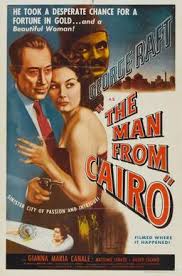
THE MAN FROM CAIRO
US, 1953, 82 minutes, Black-and-white.
George Raft, Gianna Maria Canale, Massimo Serato, Guido Celano, Irene Papas.
Directed by Ray H. Enright.
An example of the small-budget studio producing action films, often as supporting features. This film was made in Italy, using many Italian actors, including Ginna Maria Canale, very popular at this time. There is a surprise brief experience by Greek actress, Irene Papas, in one of her earliest roles, surprising as a young dancer in the club considering the very serious roles in her later career.
But, this is George Raft film. Initially a dancer, he had emerged during the 1930s in serious roles and continued through the 40s and into the 1950s, archetypal a as the gangster in Some Like it Hot. He had a fan base but many considered him very wooden in his performances. And, for those who think that this is the case, this film offers probably the best evidence.
There is quite a complex set up in the plot, gold bullion stolen during World War II, hidden in Algiers, the French government wanting it back, gangster connections stealing it. There is a survivor of the initial attack who is wanting to communicate the truth and benefit by it, a French general who has been blamed and wants exonerate himself, but from the audience point of view he acts very suspiciously. Then there is the local police, especially when the singer in the night club is murdered.
The French government have organised an American businessman to do the investigation in Algiers but first sent him to Saudi Arabia to produce a cover of his work in the oil industry. At Cairo airport, he meets an old friend, George Raft, who had served in Algiers during the war, indicating that he will be coming back to Algiers searching for a man with four fingers.
Raft is mistaken for the American undercover agent, taken by the police and interrogated, the subject of pursuit by the local thugs, his room searched, waking up to find the dead woman, and her friend appearing as he came to and his fleeing. She describes him to the police but then denies that he is the man, most improbably attracted to him but according to the screenplay almost immediately falling in love with him, introducing him to the local casino owner – all after the gold.
There is a twist, an entrepreneur illegally transporting the gold out of Algeria, disguised now as coins and hidden in the trains. Raft has been in contact with an authority with a rendezvous at the back of a fortune teller’s tent. But, he is the entrepreneur – leading to quite a confrontation, police, fights and shootouts, and an improbable romantic happy ending.
And, the strange thing, all throughout the film George Raft walks through Algiers and into the action sequences wearing coat and tie, often with a hat, standing out so obviously with all locals in the way they are dressed.
This was the last film by Ray H. Enright who had worked with Mack Sennett, editing, scripts, and had directed quite a number of fine westerns over the decades.
God + Country
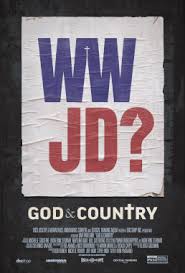
GOD + COUNTRY
US, 2023, 90 minutes, Colour.
Directed by Don Partland.
Award-winning director, Don Partland, begin a trilogy of films in 2020 focusing on the personality of Donald Trump, his years as president, his psychology, especially an analysis of narcissism. The film was released during the election year of 2020, an expose of the president as unfit for office.
God + Country was released in 2023. While there are excerpts from the public life of Donald Trump, the focus this time is on evangelical Christians. The thesis is that from the 1970s and 1980s, evangelical Christians became more and more politicised, thinking and feeling that they were under threat, relying on literal interpretation of biblical texts for their self-righteousness, identifying more and more with American right political stances.
The film offers a look at many of the evangelical Christian leaders, in their local churches, in the media, radio, and especially tele-evangelists. With their leadership and the atmosphere of feeling under threat, the vast amounts of financial contributions collected, the filmmakers suggest that there was a transition from this evangelical Christianity to more political perspectives, Christian Nationalism. And, this was very much supported by Donald Trump, irrespective of whether he was a believer or not, irrespective of his personal life and values.
The film also shows the transition to extreme right-wing groups, their invocation of Jesus Christ, Christian beliefs, specific references to biblical apocalyptic statements. It highlights that with the threat of dire end in times, the promoters of Christian Nationalism fostered an atmosphere of fear, salvation coming from the defenders on the right.
With the visuals of the storming of the Capital in January 2021, there is a climax of this kind of Christian Nationalism, the documentary highlighting images of Jesus on banners, biblical quotations, the Christian motivation of so many demonstrating, taking anti-government stands with violence, believing the lies of Donald Trump about the election being rigged.
With the release of the film in 2023, it has a significant role during 2024 and Donald Trump’s campaign for a second term as President.
Donald Partland’s third part of his trilogy is #UNTRUTH The Psychology of Trumpism, exploring further the psychology of Donald Trump himself and his followers, rabid, the right wing, the Christian Nationalists.
August Virgin, The
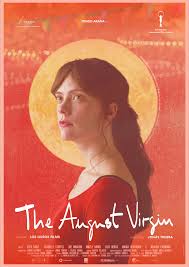
THE AUGUST VIRGIN
Spain, 2019, 125 minutes, Colour.
Itsasa Arana, Vito Sanz.
Directed by Jonas Trueba.
The Truebas have been significant filmmakers in Spain, especially Fernando, with his brother, David. The August Virgin has been corrected by Fernando’s son, Jonas.
This is very much a film for 30 somethings. 20 somethings are probably too busy with their lives to be so empathetic with Eva, the central character here, age 33, taking time off to reflect on her life and its directions. 40 somethings plus may well be impatient with Eva as they watch the film.
The introduction tells us that citizens of Madrid leave for the summer, leaving the city to tourists and to a range of entertainers as well as for celebrations of religious festivals, glimpsed during the film.
The structure of the film is a literal calendar, indicating the beginning of each day for the first 15 days of August. Eva writes a diary but the film is something of a visual diary for the audience. Some of the days are filled with action, some have only brief glimpses.
She takes up an apartment, described in great detail on the first day, base for her when she decides to go out, and as a tourist, other times just wandering, encountering an old friend at the Museum and discussing old times with him, and a drink; another time going to the cinema and meeting two old friends, further discussions; at the cinema she listens to 2 women talking and asks one of them to accompany her home for a special female massage; another time she is concerned with the man she fears is standing in a dangerous place, talks with him, befriends him, fascinated, the next night following him, talking, a sexual encounter, highlighting her preoccupation with being pregnant.
There is indication that after the first 15 days of August, she has come to some terms with herself, very much preoccupied with pregnancy – and some enigmatic references to being pregnant, no father, memories of the Virgin Mary.
Varied reactions – sympathetic audiences very involved, others irritated and bored.
- The director, his family, films and reputation?
- Madrid, the first half of August, the summer, the heat, the streets and crowds, the festivities, the concerts, the music? Apartments, bars, city locations? The musical score, the range of songs?
- The introduction, the explanations, citizens of Madrid leaving, the heat, but the celebrations in the city, the tourists? The glimpse of tourist buses and their destinations, the tourist crowds in the streets, the concerts and performances?
- The use of the calendar for the first half of August, indicating days?
- The introduction to Eva, at the apartment, the long speech from the apartment owner, his writing, interested in 1930s movie comedy and its stars, his going on vacation, showing her every detail of the apartment? Her accepting it? Relaxing in it?
- Eva, the audience not knowing much about her, in her 30s, revelation that she was an actress, gradual revelation of friends, relationships? Her reason for staying in Madrid, wanting to understand herself, being alone, her identity, the issue of pregnancy?
- The succeeding days, the keeping a diary, the film is a visual diary?
- The scenes of her wandering around, observing, in the tourist bus, following the Asian tourist, going to the museum, the encounter with her friend, his continued talking, writing articles, breakup with his girlfriend, the aftermath, her having a drink with him, his getting drunk?
- Going to the cinema, meeting the two friends, the conversations, relationships, the past, her self-consciousness, their going into the film, Eva not going, going home, writing in the diary?
- The next day going to the cinema, listening to the two women and their talk, meeting them afterwards, going home with Maria, the rituals and massage, women’s massage, periods, pregnancy?
- Seeing Agos behind the glass, her concern, crawling under the glass, the long conversation with him, actor, working at the bar, his girlfriend, the daughter with her and her boyfriend? The long talk, attraction? Her going home?
- Going to the concert in the city, the performance, dramatics, music, her enjoying it, rapt with the music? Meeting the two women again, the conversations?
- The bar, seeing Agos, later following him, their talking, the walk home, the possibility of an apartment, the room, the sexual encounter, his sleeping, her consciousness of pregnancy?
- The next day, with Agos and his daughter, the family group, the daughter and her very direct questions about pregnancy, the father, the comparisons with the Virgin Mary?
- At the end of the period, Eva and her self-understanding, looking in the mirror, her naked self, the pregnancy, her wishes, joining with a gloss and his daughter, happy times together, her future?
Beetlejuice, Beetlejuice
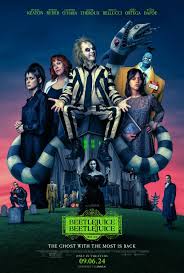
BEETLEJUICE, BEETLEJUICE
US, 2024, 105 minutes, Colour.
Michael Keaton, Winona Ryder, Catherine O'Hara, Jenna Ortega, Justin Theroux, Willem Dafoe, Monica Bellucci, Arthur Conti, Nick Kellington, Santiago Cabrera, Burn Gorman, Danny DeVito.
Directed by Tim Burton.
In Beetlejuice folklore, you have to call out Beetlejuice’s name three times and he will appear. But, this time it needed only just one repetition. And here he is, 36 years after his first appearance, ready to entertain old fans and new fans.
Perhaps it is something about the world situation in 2024 that the highest moneymaking films so far have been quite a contrast, the violent fantasy of Deadpool and Wolverine and the wonderful exploration of human motor emotions in Inside Out 2. Now Beetlejuice, Beetlejuice has made over $100 million at the American box office on its first weekend. So, we can ask, is our world with all the wars, deaths in war, cost of living crises, in need of a fantasy distraction, an indulgence in absurd comedy.
Because, that is what we have here, absurd characters in over the top absurd situations, lots of jokes, special ghostly effects, Beetlejuice’s wisecracks, all kinds of unexpected dramatic turns. There is a surface world with strange human characters, Winona Ryder again as Lydia now a TV host on ghost appearances, her mother, Catherine O’Hara again as Delia, an eccentrically loud artist – but Astrid, Lydia’s daughter, Jenna Ortega, has grown up sceptical of the whole Beetlejuice ghostly world. Her scepticism is about to come crashing down. And director, Tim Burton, going back to his old fantasy styles.
In the meantime, there in the Afterlife, Michael Keaton is Beetlejuice, always sly, raucously comic, with a host of office secretaries, all skeletal bureaucrats, especially the hapless Bob, suited, but in for some tormented times because a callous janitor in the Afterlife, played by Danny DeVito, vacuuming and polishing, the machine in water, electric shock and opening up the store of dead severed human parts – especially, of Beetlejuice’s former wife, played exotically by Monica Bellucci who will pursue him relentlessly.
Fans of the original will be happy to get back into the Afterlife, the madcap visuals, the special effects, the eerie creatures… And there is plenty of plot, Astrid tricked into helping a ghost to regain his life, Lydia to the rescue and agreeing to marry Beetlejuice, his wife in pursuit, Delia ending up in the Afterlife, and, to cap it all, Willem Dafoe, seeming to appear in every other film these days, as a skeletal actor who is in charge of investigations, preening himself in his performance, modelled on television shows, of how the police ought to act!
And, right at the end, there is a very long wedding sequence, all kinds of mayhem with a performance of McArthur Park, everybody singing along…
Beetlejuice may not appeal to every audience, especially those who don’t have a high tolerance for dark fantasy. But, he will probably appeal, in his own very distinctive Michael Keaton way, to most everyone else!
Rebel Ridge
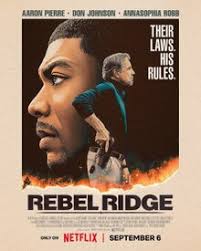
REBEL RIDGE
US, 2024, 131 minutes, Colour.
Aaron Pierre, Don Johnson, AnnaSophia Robb, David Denman, Emory Cohen, Steve Zissis, Zsane the, James Cromwell.
Directed by Jeremy Saulnier.
We are in Louisiana, definitely the atmosphere of the South, arrogant cops, political corruption, the treatment of an itinerant black man.
This is the kind of action film where the audience is invited to sympathise with the central character, in this case, Terry Richmond, played by British actor Aaron Pierre. He is riding his bicycle along Louisiana Road, bumped to the ground by pursuing police, treated as a suspect, all kinds of charges, no belief in his defence that he is carrying $30,000 to get to the court to place bail for one of his cousin. He is treated with contempt as well as disbelief, brutally treated, and his seeming to accept something of his fate.
Then we are introduced to the chief of police, played by Don Johnson, and audience hostility goes up several degrees. We see the corruption, get information that there have been many victims like Terry Richmond, and information that budgets are tight and the local police need this kind of forfeiting of money in such situations.
There is also a sympathetic young woman, Summer (AnnaSophia Robb) who is able to give Terry some documentation about the history of corruption.
By this stage, we are halfway through the film. Which means, of course, that Terry Richmond will come into his own, self-assertion, collaboration with Summer even as the police turn on her. The assistant at the police station does a bit of googling and, just a bit too late, finds out just who Terry Richmond is and what are his military qualifications.
While we might say that this action scenario is somewhat formulaic, that does not undermine the effect of audience identification with the central characters and the injustices, loathing of the corrupt police, the various stages of their comeuppance
As expected, the action becomes violent at times, and disgust at the lengths the police will go to justify themselves and eliminate opposition.
- The title? Louisiana? Attitudes of the American South? Race issues? Policing? Corruption?
- The Louisiana settings, the countryside, the towns, homes, police offices? The musical score?
- Terry Richmond, riding his bike, the pursuit by the police, stopped, apprehension, suspicions? His explanation, bail for his cousin? African-American?
- This kind of drama eliciting audience sympathy for the persecuted central character, the second half and the comeuppance of the persecutors?
- Terry, character, working in the restaurant, the Chinese background, phoning, raising the money, the restaurant attacked by thugs, his cousin and drug deals, wanting to post the bail? Arriving in the town, the interrogation by the police, in the cell? The encounter with the chief? The two arresting officers and their attitudes and behaviour?
- The financial situation of the police, the chief and his plan, the offices, the female officer in the office, her googling, finding out the truth about Terry? Taking of the money, the legal holding of the money, the use of the money, the cabinet full of weapons? Financial deals, the legal implications? The role of the judge – and the later interrogation, his killing himself?
- Summer, her background, drugs, rehabilitation, the judge, getting the job, her child? Talking with Terry, giving information, the meetings, the leads, the indication of an inside informer, presumption that it was the woman, the later revelation of Marston?
- Terry, the confrontation with the chief, verbal, physical? His military training, his skills? The exercise?
- The move towards resolution, the transfer of the prisoners, his riding by pursuing the bus, reassuring his cousin? The later news of his death?
- The complexities of the set-ups, his allowing himself to be taken, the drugging of Summer, the threats? Driving away, the ambushes, the shootouts, Rebel Ridge? Confrontation with the chief? Marston revealed?
- A picture of small town corruption, violent consequences, exposing the corruption, resolution?
Photos from the Randwick parish celebration of Our Lady of the Sacred Heart
Photos from the Randwick parish celebration of Our Lady of the Sacred Heart

Pat Mara MSC, PP, Michael Nithin MSC assistant, and in the meal photo, Bill Brady MSC, Assistant
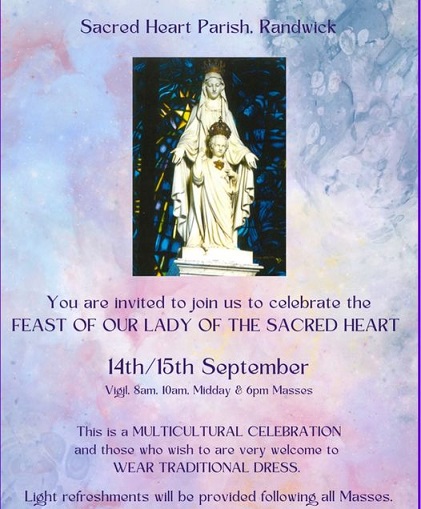

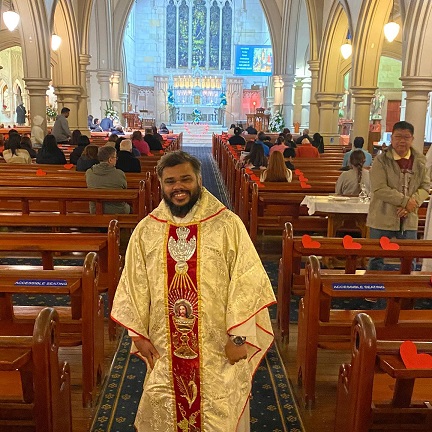



A Pleasing MSC story
A Pleasing MSC story:
Fr. Albert Boudaud MSC, Papua New Guinea’s oldest missionary

Albert Boudaud, missionnaire français en Papouasie Nouvelle Guinée, Camille Dalmas - published on 09/11/24 in ALETEIA.
Albert Boudaud turned 84 in August, and he’s Papua New Guinea's oldest missionary. Meet this priest who arrived in what is now his adopted country in 1968.
A journalist colleague with a sharp eye noticed this elderly man with a goatee sitting on a bench at the Mary Help of Christians shrine in Port Moresby, Papua New Guinea. Cooling himself under a large ceiling fan, Fr. Albert Boudaud had come to listen to Pope Francis and flinched a little when he was addressed in French, as if he hadn't heard it for 10 years. “I'm sorry, I've forgotten my French,” apologized this modest old man, who nevertheless spoke his native tongue with a certain elegance throughout the interview.
Seated in the front rows, Fr. Boudaud received the honors befitting the country's eldest missionary. After all, he's been here since 1968. How did he end up there, at the age of 28?
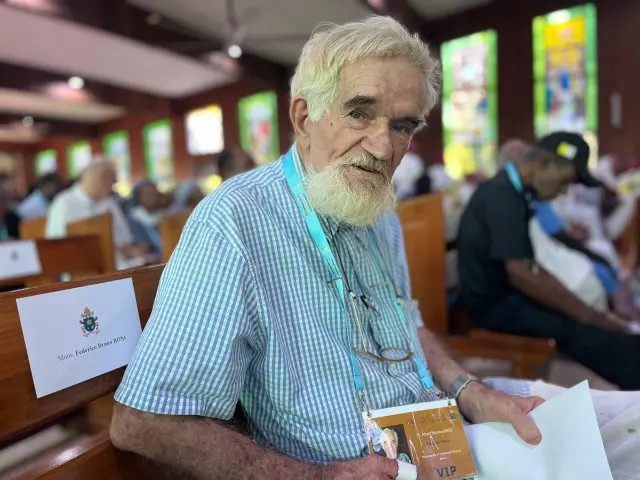
Aleteia
Bored and procrastinating, and then…
It's the story of a young man from the Vendée who was bored at the diocesan seminary in Les Herbiers. Then, Albert met a missionary who inspired him to dream of adventure. After procrastinating for two years, he joined the Missionaries of the Sacred Heart in Issoudun and was ordained in 1967.
He was sent to spend a pastoral year in the Paris suburb of Plaine Saint-Denis, which was “also a missionary environment.” At the end of this powerful experience, his superiors proposed that Father Boudaud go to Papua New Guinea, a place where his congregation were pioneers. He immediately signed up, packed his bag, took barely enough time to learn English, and set off on a quick vacation before going to the port of Marseille for his departure.
From there, the priest embarked on a long 45-day voyage that took him across the Mediterranean, the Atlantic, and finally to the Pacific via the Panama Canal. He remembers sailing the Pacific Ocean for nine days without seeing anything but water. Then came the Marquesas, Vanuatu, New Caledonia, and Sydney. And from there, he traveled to Port Moresby. He didn't make the return trip until 10 years later, on vacation, but he has no regrets. “I came voluntarily, I integrated myself, I made it my country by living close to the people,” he tells us.
Multilingual missionary: With his feet on the ground in his missionary territory, this linguistics enthusiast found just what he was looking for: Papua has over 800 different languages, not counting the dialects... Moving from village to village, he learned one, then two, then three... When asked how many he knows today, he has a bit of trouble keeping count, as the list is so exhaustive.
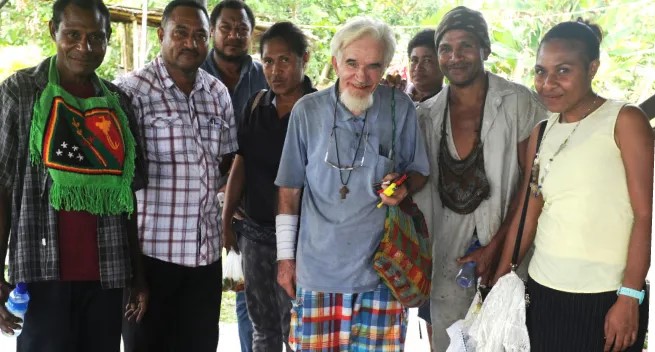
PNG Post-Courier
To fit in, he also had to chew areca nut, the natural drug — also known as betel nut — that turns the teeth of so many Papua New Guineans red (and causes mouth cancer). “When the situation was a bit difficult, we’d chew together and that made it possible to get things done.”
Shoes and sandals wore out during these years of mission, when he wasn’t simply going barefoot over muddy terrain. He took the Gospel and the Eucharist on “patrols” to remote villages. He remembers being bitten by snakes before chasing them away with a stick.
He also has baptized people everywhere. “It's our most important job,” he insists. He spent several days in each village, celebrating Mass and conferring the sacraments.
After a long life of service, he retired a few years ago, and now offers his broad smile and stories to the Catholics of Papua New Guinea. “The work is now more for the Indigenous priests,” he concludes. His piercing blue gaze is now lost in memories, as polyphonic harmonies resound in the shrine’s nave.


